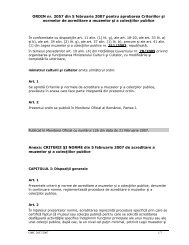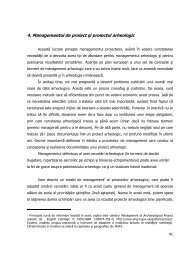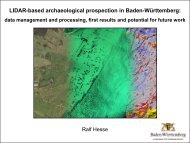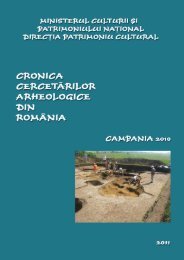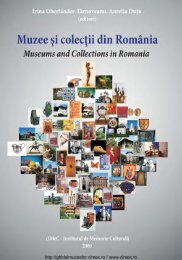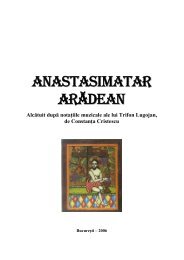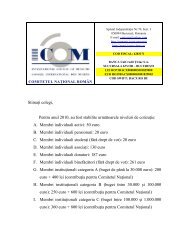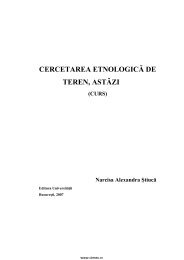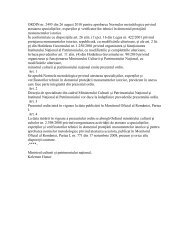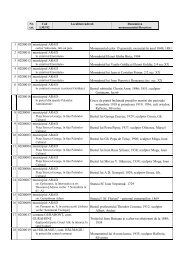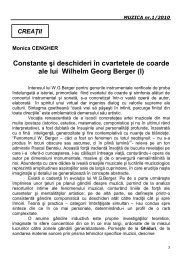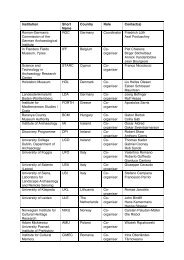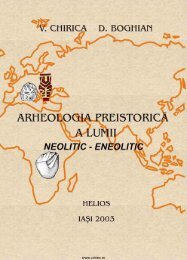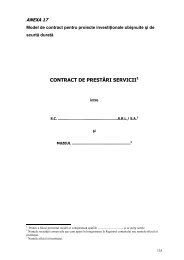pdf (15 MB) - cIMeC
pdf (15 MB) - cIMeC
pdf (15 MB) - cIMeC
You also want an ePaper? Increase the reach of your titles
YUMPU automatically turns print PDFs into web optimized ePapers that Google loves.
Cronica cercetărilor arheologice din România – campania 2006<br />
asemenea, au fost amenajate, pe drumul înspre cetate,<br />
marcaje şi locuri de popas pentru turişti.<br />
Materialele arheologice descoperite în campania anului<br />
2006 au fost spălate, marcate şi inventariate la MCR, conform<br />
protocolului încheiat cu acesta.<br />
S-au folosit mijloace clasice şi moderne de înregistrare a<br />
descoperirilor: staţii GPS, staţie totală, aparate foto digitale,<br />
camere video etc.,<br />
Pl. 32<br />
At the end of campaign basic conservation measures have<br />
been taken for the walls uncovered on the second terrace and<br />
the bastion.<br />
The archaeological materials of the campaign 2006 were<br />
washed up, marked and inventoried at the National History<br />
Museum of the Eastern Carpathians in Sfântu Gheorghe<br />
following the agreement signed up with this institution.<br />
Note:<br />
1. A székeyfőld leirasa, Pesta, III, 1869<br />
2. Documentaţia de şantier întocmită de Al. Ferenczi s-a<br />
pierdut. O parte din materialele descoperite de el se află la<br />
MNIT<br />
3. C. Daicoviciu şi colaboratorii, SCIV 1, 1950, p. 119-120;<br />
4. Z. Szekely, SCIV 23, 1972, 2, p. 201 – 214;<br />
5. A se vedea site-ul www.simpara.ro<br />
Abstract:<br />
During the campaign of 2006 sections S7E and S7F were<br />
finalized. A new section, S7G, was opened in the junction area<br />
between the 2 nd and 3 rd terraces. At the same time basic<br />
measures of preservation have been taken for the unveiled<br />
walls.<br />
The section S7E was placed already in the previous<br />
campaigns on the second terrace and now it was extended.<br />
The aim was: to entirely unveil the bastion’s eastern corner<br />
and its side on the terrace; the inner side of the second<br />
terrace’s courtine; to entirely preserve the ESE profile for<br />
stratigraphical reason. Section S7F was marked up in the<br />
previous campaign on the 2 nd terrace slope to release the SE<br />
side of the bastion and to identify the outer side of the courtine.<br />
The aims of this year campaign were all fulfilled.<br />
On the ESE profile of the section S7E two large layers of<br />
fittings out. They are delimited by a strong layer of yellow clay<br />
and pigments. Three phases of fitting out were identified in the<br />
first layer while the second level is a compact one. The<br />
situation revealed by this profile is a confirmation of what we<br />
have observed in the previous years on the ESE profile of the<br />
section S18. At the same time, a construction of large sizes<br />
was unveiled in section S 7E. It belongs to the third phase of<br />
the first level of Dacian inhabitancy.<br />
In the uncovered area the wall on the edge of the second<br />
terrace is 4.20 wide and is stuck to the ESE side of the bastion.<br />
The inner side of the wall is preserved at height 1.10 m while<br />
the outer side for 0.85 m. On its external side the wall was<br />
“laid” on a bank of gritstone and yellow soil with gritstone<br />
splinters.<br />
On its best preserved side the bastion’s SE side has a<br />
height of 3.70 m. In the southern corner of the bastion was<br />
discovered a new platform (B2) an analogy for the platform<br />
(B1) located in the western corner of the same bastion.<br />
A rich and various archaeological material was found:<br />
Dacian pottery (wheel- and hand made), fragments of terra<br />
sigillata from the Black Sea, iron and bronze brooches, bronze<br />
necklaces, bracelets, beads, bronze and silver pendants, iron<br />
knives, loom weights etc. Most of the material was found in the<br />
building researched in the section S7E.<br />
Section S7G was not finished and it will be done in the<br />
following campaigns.<br />
140<br />
70. Craiva, com. Cricău, jud. Alba<br />
Punct: Piatra Craivii<br />
Cod sit: 4160.01<br />
Autorizaţia de cercetare arheologică sistematică nr. 7/2006<br />
Colectiv: Vasile Moga - responsabil, Cristinel Plantos –<br />
responsabil sector (MNUAI), Daniel Costin Ţuţuianu -<br />
responsabil sector, Antoniu Marc (MCDR Deva), Marius<br />
Breazu, masterand Mircea Gligor (Univ. Alba Iulia)<br />
În intervalul cuprins între 07 iulie – 06 august 2006, cu<br />
fonduri de la C.J Alba 1 şi MCC au continuat cercetările<br />
arheologice sistematice în situl de la Craiva „Piatra Craivii”.<br />
Situl arheolgic de la „Piatra Craivii" se află plasat, din punct<br />
de vedere fizico-geografic, pe ramura de SE a Munţilor<br />
Apuseni, în subdiviziunea Trascău pe, o klippă calcaroasă cu o<br />
altitudine maximă de 1078 m. Stânca dominantă, aflată nu<br />
departe de valea Mureşului, la 20 km N de Alba Iulia, oferă o<br />
excelentă vizibilitate în bazinul mijlociu al râului mai sus<br />
menţionat. Motivaţia aşezării comunităţilor umane de-a lungul<br />
timpului aici (din preistorie şi până spre sfârşitul evului mediu)<br />
se leagă de bogatele zăcăminte metalifere din acest areal<br />
alaturi, evident, de poziţia strategică în controlul rutelor de<br />
comunicaţie din acest areal.<br />
Chiar dacă o serie de artefacte de la Piatra Craivii provin<br />
din descoperiri arheologice datând de la sfârşitul veacului al<br />
XIX-lea, investigaţiilor arheologice sistematice, de aici, sunt<br />
legate de cercetările începute în anul 1960 de către Gh.<br />
Anghel la fortificaţia medievală, cu prilejul cărora au apărurut şi<br />
materiale aparţinând epocii dacice. Ca urmare, în campaniile<br />
următoare cercetările se vor intensifica şi vor duce la o lărgire<br />
a colectivului sub îndrumarea lui I. Berciu. Astfel, s-au<br />
descoperit şi cercetat mai multe terase antropogene alături de<br />
fortificaţia a ceea ce se va dovedi un important centru de<br />
putere dacic, indentificat ipotetic ca şi anticul Apoulon. Între<br />
descoperirile remarcabile se numără o serie de spaţii de cult,<br />
ateliere etc. O serie de verificări şi sondaje, care au dus,<br />
printre altele la descoperirea unui al treilea sanctuar, au fost<br />
efectuate spre sfârşitul anilor ́80 de către I. Glodariu şi V.<br />
Moga.<br />
Obiectivele campaniei din cursul anului 2006 au constat în<br />
continuarea cercetarilor în sectoarele începute în campania din<br />
anul 2005, anume pe terasa a V-a şi în punctul „Şura” dar şi<br />
deschiderea unor noi suprafeţe, în speţă pe terasa Bănuţului şi<br />
pe terasa a IX-a, alături de dezvelirea sanctuarului de pe<br />
„terasa balcon”.<br />
În S I, de pe terasa a V-a, s-a continuat cercetarea incintei<br />
circulare. Din păcate, aceasta ce a fost vandalizată în toamna<br />
anului 2005. În contextul în care regimul termic de peste iarnă<br />
a afectat cele două profiluri longitudinale, unitatea de săpătură<br />
a fost lăţită cu câte 10 cm pe fiecare latură. Cercetarea parţială<br />
a ei ne-a oferit noi informaţii cu privire la datare, (prezenţa unui




